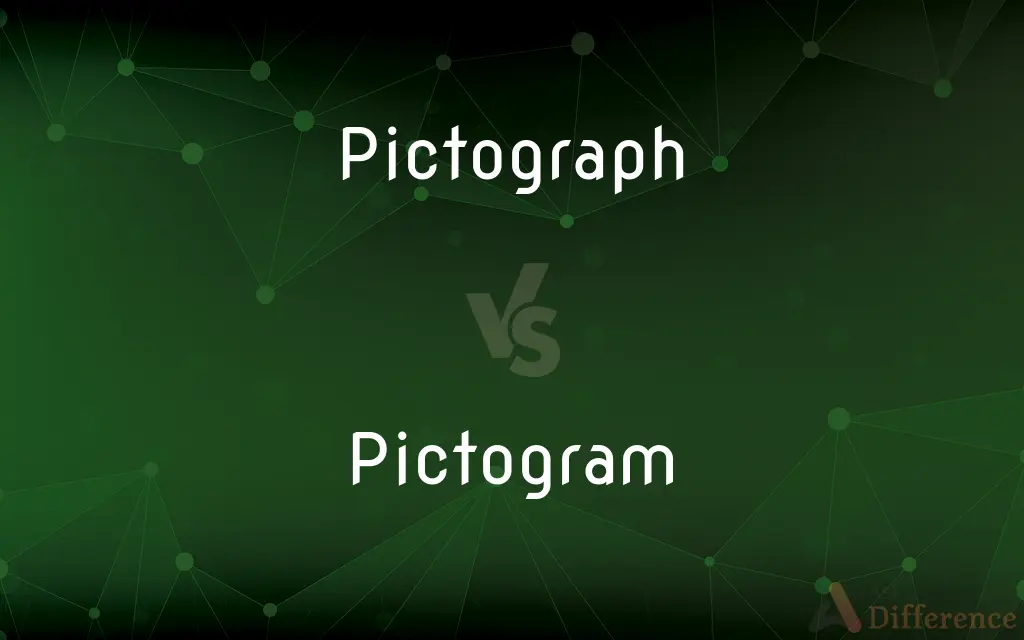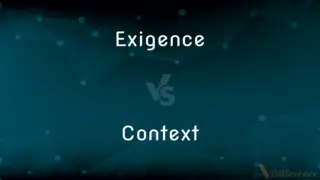Pictograph vs. Pictogram — What's the Difference?
Edited by Tayyaba Rehman — By Maham Liaqat — Updated on March 18, 2024
A pictograph represents data using images, while a pictogram conveys concepts or identities through simplified visual forms.

Difference Between Pictograph and Pictogram
Table of Contents
ADVERTISEMENT
Key Differences
Pictographs often serve in statistical data representation, using images or symbols to depict quantities, making information easier to understand at a glance. Each symbol in a pictograph corresponds to a certain number of items or units, and these symbols are often repeated to show larger quantities. On the other hand, pictograms are used in various contexts to represent objects, activities, places, or services with simple, universally recognizable images. They are commonly found in public spaces, instructions, and informational signage, where quick and clear communication is essential.
While pictographs are primarily used in educational and informational materials to simplify the presentation of data and statistics, pictograms play a crucial role in international communication. They transcend language barriers by providing a universal language of symbols. For example, international symbols for restrooms, airports, and no smoking areas rely on pictograms for immediate recognition.
Pictographs can incorporate colors, sizes, and shapes of symbols to represent different data categories or values, making complex information more digestible. However, pictograms prioritize minimalistic design and universal understandability, often using black and white symbols to convey messages effectively without the need for text.
In educational settings, pictographs are valuable tools for introducing young students to basic concepts of graphing and data interpretation. They visually break down numerical information, making it accessible to learners at various levels. Conversely, pictograms are integral to safety and navigation, providing instant guidance and warnings to people of all ages and backgrounds.
Despite their visual similarities, the primary distinction lies in their application and purpose: pictographs are tailored for data visualization and educational purposes, whereas pictograms are designed for quick, intuitive communication in everyday scenarios.
ADVERTISEMENT
Comparison Chart
Definition
A visual representation of data using symbols or images.
A symbol representing an object, activity, place, or service.
Primary Use
Data representation in statistics and education.
Communication in public spaces and signage.
Symbol Repetition
Often used to represent quantities.
Typically used once for clear, immediate recognition.
Complexity
Can vary, sometimes detailed to represent data.
Simplified and stylized for universal understanding.
Dependence on Text
May include text for clarification.
Minimally uses text, focusing on universal imagery.
Compare with Definitions
Pictograph
A graph using symbols to represent data quantities.
A pictograph of apples might show four apple icons to represent 40 apples, assuming each icon equals 10 apples.
Pictogram
An icon used in public signage for easy navigation.
Bathroom pictograms help visitors find facilities in airports.
Pictograph
A chart where symbols stand in for numbers of units.
In our survey pictograph, each smiley face represents five satisfied customers.
Pictogram
A simple image representing a concept or facility.
The pictogram for the train station is universally recognized.
Pictograph
A visual tool in statistics for simplifying data interpretation.
The classroom's pictograph displayed students' favorite fruits with icons.
Pictogram
A graphic symbol conveying instructions or warnings.
The washing machine's pictograms explain different wash cycles.
Pictograph
An educational resource to introduce children to graphing.
We used a pictograph with star icons to count the class's book reading achievements.
Pictogram
A tool in visual communication crossing language barriers.
Emergency exit pictograms provide quick evacuation directions.
Pictograph
A method of depicting numerical information visually.
The pictograph on water usage made the conservation message clearer.
Pictogram
A minimalist design for representing everyday concepts.
The no-smoking pictogram is clear without any words.
Pictograph
A picture representing a word, phrase, or idea, especially one used in early writing systems.
Pictogram
A pictogram, also called a pictogramme, pictograph, or simply picto, and in computer usage an icon, is a graphic symbol that conveys its meaning through its pictorial resemblance to a physical object. Pictographs are often used in writing and graphic systems in which the characters are to a considerable extent pictorial in appearance.
Pictograph
A pictorial representation of numerical data or relationships, especially a graph, but having each value represented by a proportional number of pictures. In both senses also called pictogram.
Pictogram
See pictograph.
Pictograph
A picture that represents a word or an idea.
Pictogram
A picture that represents a word or an idea by illustration.
Pictograph
A graphic character.
Pictograph
A graph that represents numerical data using pictures.
Pictograph
A picture or hieroglyph representing and expressing an idea.
Pictograph
A graphic character used in picture writing
Common Curiosities
Why are pictograms important in public spaces?
Pictograms provide quick, intuitive communication and guidance, essential in public spaces.
Where are pictograms most often seen?
Pictograms are frequently found in public signage, instructions, and international symbols.
What is a pictograph?
A pictograph is a chart or graph that uses symbols or images to represent data.
Can pictographs show detailed data?
Yes, pictographs can show detailed data by varying the symbols' colors, sizes, and repetitions.
Are pictograms always simple in design?
Yes, pictograms are designed to be simple and universally understandable.
How are pictograms created to be universally understood?
Pictograms are created with simplified, stylized designs that focus on universal visual elements.
Where are pictographs commonly used?
Pictographs are commonly used in education and for presenting statistical data.
What is a pictogram?
A pictogram is a symbol that represents an object, activity, place, or service.
How do children benefit from pictographs?
Pictographs introduce children to basic concepts of graphing and data interpretation in an accessible way.
What role do pictograms play in safety?
Pictograms are crucial for conveying safety instructions and warnings quickly.
Are pictograms used internationally?
Yes, pictograms are used internationally, especially in areas where language barriers exist.
Do pictographs always include text?
Pictographs may include text for clarification, but the focus is on the symbols.
What is the main difference between a pictograph and a pictogram?
The main difference lies in their use; pictographs are for data representation, while pictograms are for communication.
Can pictographs represent any type of data?
Pictographs are versatile and can represent a wide range of numerical data.
Do pictographs need to be colorful?
While not necessary, colors in pictographs can help differentiate data categories.
Share Your Discovery

Previous Comparison
Exigence vs. Context
Next Comparison
Majority vs. MinorityAuthor Spotlight
Written by
Maham LiaqatEdited by
Tayyaba RehmanTayyaba Rehman is a distinguished writer, currently serving as a primary contributor to askdifference.com. As a researcher in semantics and etymology, Tayyaba's passion for the complexity of languages and their distinctions has found a perfect home on the platform. Tayyaba delves into the intricacies of language, distinguishing between commonly confused words and phrases, thereby providing clarity for readers worldwide.
















































